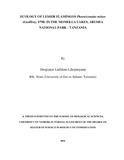| dc.description.abstract | This study was carried out in Lake Big Momella and Lake Rishateni found in Arusha National Park (ANAPA) -Tanzania. It explored the factors that influence food availability and habitat utilization of lesser flamingos Phoeniconaias minor (Geoffroy, 1798) following their frequent deaths and general population decline in the lakes. The factors included water quality, algal biomass and lake morphometry. Data collection of the variables under study was undertaken on monthly basis during the period between months of November, 2013 and May, 2014.
It was established in both lakes that all physicochemical parameters except salinity and pH showed a significantly positive correlation with algal biomass and proliferation of algal blooms. However, the influence of electrical conductivity, salinity and total nitrogen on algal biomass differed significantly between the two lakes (F 1, 13 = 34.578, p = 0.005, F 1, 13 = 617.522, p < 0.005 and F 1, 13 = 5.975, p < 0.031 respectively). Harmful species e.g. Microcystis and Anabaenopsis were also identified in the algal blooms from both lakes. Total number of lesser flamingos in Lake Big Momella and Lake Rishateni negatively correlated with algal biomass (r = - 828, p < 0.022 and r = - 0.792, p < 0.034 respectively). A negative significant correlation also existed between the total number of lesser flamingos and water depth in lakes Big Momella and Rishateni (r = - 0.859, p < 0.006 and r = - 0.875, p < 0.004 respectively). It can be inferred from the findings of this study that shifts in algal biomass, proliferation of algal blooms, the presence of harmful algal species and seasonal fluctuations in water level that contaminated the food and affected habitat utilization could have contributed to the frequent deaths observed and general decline in numbers of lesser flamingos in the lakes. Based on the findings this study recommends protection of the Momella lakes ecosystem by protecting soil, water sources and catchment areas which is important for monitoring good water quality. Identification of specific cyanotoxins that are lethal to the lesser flamingos should also be put into consideration. | en_US |

